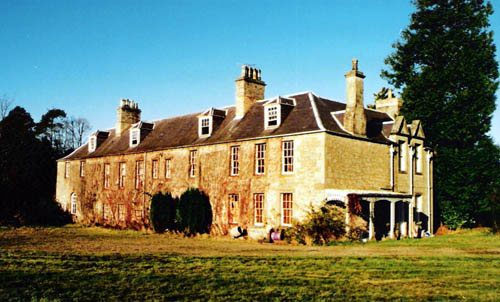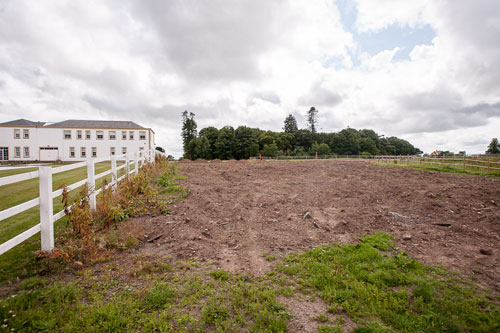A STATELY home has been demolished after it failed to sell for £1.
The B-listed Georgian mansion, once home to some of the wealthiest families in Scotland, needed repairs in excess of £1m.
But after the owners of Whitehall House, Chirnside, Berwickshire, failed to find a buyer they were given permission to knock the 250-year-old building down.
Whitehall House was regarded as “regionally significant”. The sandstone mansion included a beautifully ornate music room and fine examples of architecture.

In its heyday it was the lavish, seven-bedroomed residence of notable Scottish families including the Hall family of Dunglass and the Mitchell-Innes family, who built nearby Ayton Castle.
But after falling into a state of disrepair it was put on the market for a sale price of £1 and a clear stipulation that refurbishment of £1.2m would have to be funded.
After no buyers came forward, owner Douglas Pryde, a financial advisor, was given permission by Scottish Borders Council and Historic Scotland to go ahead with demolition.
A large, modern-looking property now stands near the site of Whitehall House, which is now just a patch of bare earth.
Mark Douglas, Scottish Borders Council Planning Officer, confirmed: “The house is no more. Consent was given for its demolition.
“It was a long a difficult case. It was in poor condition. There was no doubt about that. It would be an expensive project. No buyer came forward.”
He added: “We try our best to not lose buildings. We engaged with Historic Scotland and the owner, he did follow the correct procedure.
“Unfortunately, in spite of trying, it is no more.”

The house, which sat in the quiet hillside village near Duns, once included a beautiful arcaded verandah, servants’ quarters in the attic and a walled garden.
Its pièce de résistance, however, was the music room which had decorative Italian plasterwork depicting musical instruments and naturalistic scenes.
The house is still listed online as being on the Buildings at Risk Register for Scotland and is included on the Wikipedia page for the town as a notable building.
Although the precise date it was built is unclear it was recorded on a map of the area in 1771.
Edward Seymour, of estate agents Edwin Thompson, said of the 18th Century home: “There was an awful lot of interest. We had enquiries from as far afield as India.
“No offer was made for it.”
Scottish Borders Council’s report on the property stated: “The property has been marketed at a price reflecting its location and condition to potential restoring purchasers for a reasonable period without success.
“With regret it is accepted that the listed building can be demolished.”
Robert Bargery, Director of the Georgian Group, a charity which campaigns to preserve the heritage of the era, said: “It looks like it could have been restored. It was pretty much intact.”
He claimed: “It would have been nice for the owner, who built a new house near by, to have used the funds to restore the listed house instead. Maybe they thought it was just too onerous a task?
“It is unfortunate it was demolished apparently to be replaced by thin air. Could it not have been left until someone did come forward?.”
Mr Bargery said Scotland was lucky to have many Georgian houses but added: “They get fewer by the minute if you start demolishing them. It’s a sad loss.”

Liz Fuller, a buildings at risk officer from Save Britain’s Heritage said she was “saddened” to hear the building had been demolished.
She said: “We are always saddened to hear of the loss of a historic building which could have found a new use.
“We have seen many examples of buildings with character, even in an advanced state of decay, being rescued and given new life by new owners with the vision and commitment to see this kind of project through.”
A spokeswoman for The Architectural Heritage Society of Scotland said: “On principle we are against the demolition of listed buildings when there is another possible use of the building.”
She added: “Sometimes it doesn’t seem to work out which is a shame.”
Neil Baxter, secretary of The Royal Incorporation of Architects in Scotland, said: “It went through due process is terms of all the permissions.
“I think what you have to do is ensure you have tested the market in a robust way.
“The £1 thing was a good try. It’s a pity it didn’t work.”
A spokesman for the council said: “It would appear from the documents connected to the application that after all information was provided by the applicant there were no objections to the demolition.
A spokesman for Historic Scotland said: “We worked closely with Scottish Borders Council to ensure all avenues were examined to retain Whitehall House which included an additional marketing campaign aimed at restoring purchasers.
“It was only after no offers were received during this process that we agreed that the Scottish Historic Environment Policy (SHEP) test for demolition had been met.
“Therefore, when the Council informed us of their intention to allow demolition, we cleared the case back to them to issue consent.”
Mr Pryde was not available for comment.

